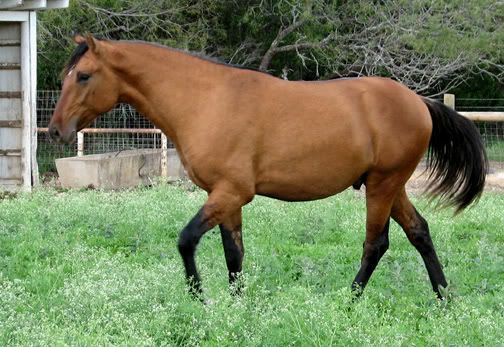|
|
Post by Michelle Clarke on Jul 18, 2011 12:15:42 GMT -5
Okay, been thinking of this for awhile. I know there are plenty of dun and grullos (red duns too) that are considered having dun factor, yet do not have very distinguishable leg bars. Some have cobwebbing, some very muddy and some just have black (or darker red) leggings. They have obvious other dun characteristics such as dorsal, ear markings, face mask, etc. Since it is also believed that the dun genes are actually a cluster, than it makes sense that some horses have more "dun factor" than others to begin with. So. You take a horse like Dino (hope it's okay to use him as an example Kevin!). He is clearly a dun and has had dun offspring from non-dun mares. However, from the picts I looked at in the stallion thread, it does not appear he has very noticeable leg bars (please correct me if I am wrong). I've seen other duns like this and grullos too. Desi (red dun) had cobwebbing and not really striping but there was no denying he had the dun factor. Take Hawk. For all general purposes, he looks like a bay - until you notice the leg stripes and of course his dorsal. Here he is in his bleached out summer coat - I need to get a winter picture up too.  Then take the suspected duns in other breeds that are now being tested (like dunalinos who look plain palamino and blacks who are really grullos) that have no dorsal and/or no leg barrings - they are testing positive and have dun offspring to prove it. So, with all of that said - does striping make a horse a dun or not? |
|
grullagirl
Weanling
  Have you hugged your horse today?
Have you hugged your horse today?
Posts: 238
|
Post by grullagirl on Jul 22, 2011 22:39:39 GMT -5
I think this is a great discussion. Its so amazing today how there can be jet black horse who are actually grullas and false duns that can pass for your average day dun. There is a lusitano or andalusian stallion advertised in magazine as a grulla. He even tested positive for the dun gene. The hard thing is he's a blue/black metallic color so very hard to see any stripes.I'll have to find some picks to post. Thats so true about Desi he made even more confusing with how his coat color looked nothing like a red dun LOL.
|
|
|
|
Post by DianneC on Jul 23, 2011 9:10:03 GMT -5
There are two parts to being dun. One is genetic, the ability to throw dun. The other is the appearance of stripes and dun factor markings. The real test is the ability to throw dun, because if the genes are there then the stripes are too, although they may not be easily visible. That being said, I think a crisp dorsal, called an eel stripe for its hard edges, is the minimum requirement. But even that may not be visible except if a black-looking horse is sun-faded. Super light horses are also hard to see. Since the dun gene is thought to be a cluster of genes some parts may be lost, like bi-coloring, leg stripes, ghost smile or even a small part of the dorsal stripe.
One clue to whether a black horse is black or grulla is that a black horse is black all over. So if you pick up the tail and see a grulla color then the horse is not just black, same with the fawn color inside the ears. I have seen fawn color inside the ears on buckskins though, so that is not a reliable test by itself in my opinion. Maybe Kim can help us out with what the KMA registration committee looks for. I know the KMA inspectors used to carry a black light, as the leg stripes etc were more visible on black horses with it.
|
|